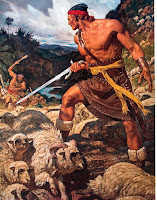 |
| From Mars by Fuyumi Soryo |
Granted, what makes good art is somewhat subjective (though not entirely: whether or not I like Picasso may be subjective; Michelangelo's David is great art). However, I have noticed certain criteria popping up again and again in my summer manga reading, namely three:
1. Good manga art gets the proportions right WHEN REQUIRED.
 |
| Friberg |
You will see the type I prefer by the manga examples I post.
 The important point is that whatever the style, the proportions are accurate to that style. Every now and again, while reading a manga, I find myself doing the same thing I do when I watch Golden Girls, and I start fretting about the fact that there is really no way the outside of the house matches the inside.
The important point is that whatever the style, the proportions are accurate to that style. Every now and again, while reading a manga, I find myself doing the same thing I do when I watch Golden Girls, and I start fretting about the fact that there is really no way the outside of the house matches the inside.I've been reading manga where I've suddenly yelled, "Look, most people's fingers fall below the middle of their thighs. NOBODY'S ARMS LOOK LIKE THAT WHAT YOU'VE DRAWN! Have you never heard of the Golden Ratio!?"
2. Better than usual manga captures motion.
 This is actually terrifically difficult to do--consequently, much manga falls into two categories (1) "beautiful pauses"; (2) motion.
This is actually terrifically difficult to do--consequently, much manga falls into two categories (1) "beautiful pauses"; (2) motion.

Those who employ the pause technique can produce lovely and heartrending stuff. Fuyumi Soryo of Mars and Eternal Sabbath creates stunningly beautiful images (see opening image above.) Although the pieces are more set, they do signal a sense of immediacy: a camera still rather than an oil painting.
The difficulty of manga art is that it needs to be more like the first rather than the second, no matter what art class tells you.
 |
| "L" from Death Note |
And then there's Takeshi Obata of Death Note who occupies a category of his own.
3. The manga art conveys emotion.
This is the most important criteria.
 Yana Toboso of Black Butler effortlessly captures Sebastian's uncertainty (which is NEVER vocalized in the first volumes: he is a devil after all). Sebastian's outsized confidence is captured best in the cover art below.
Yana Toboso of Black Butler effortlessly captures Sebastian's uncertainty (which is NEVER vocalized in the first volumes: he is a devil after all). Sebastian's outsized confidence is captured best in the cover art below.Soryo captures young male insouciance at its most quintessential (see above).

Obata captures "L"'s confidence yet concern (see above).

And Matoh delivers a sense of fatigue (to the right) and would even without the thought bubble!
Like Maximus from Tangled, a well-drawn manga character can look
deadpan or excited, sad or happy, and even exasperated!
(If you want to have fun, look at the pictures on this post in order--every time, I reach Maximus, I start giggling.)
A picture in manga doesn't convey a thousand words--it conveys a thousand states of mind.


2 comments:
David IS a cartoon character. A great deal of great art is graphic art. At some point in my museum-visiting career I went through a room of Botticelli's. All of it is lines with color filled in.
Anyway, great post.
What is amazing to me about great art/graphic art is how much more real it is than, well, reality. Calvin & Hobbes, for instance, conveys so EXACTLY how an overactive little boy behaves, I wouldn't believe it more if it was all photographs.
Which brings up the whole issue of how humans are . . . trained? . . . born? . . . to "see." Like the optical illusion where the two monsters are the same size but the one in the back looks bigger because our eyes are trained to "know" that objects in the background are usually smaller than ones in the foreground: optical illusion.
Post a Comment